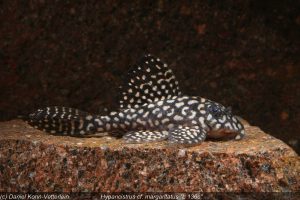Neither the species nor the particularly attractive form treated here, which became known in aquaristics with the addition “c”, is something really new. In the last two to three years, however, there have been some changes in selection and linebreeding, which is why a particularly beautiful specimen is presented here.
 It is an offspring of BSSW-member Timo Schellenberg, who keeps and breeds the species in all three variants (a, b and c) for quite some time now. For his group of c-specimens he only selects those that really have potential and accordingly this group is small compared to the others. Only about 4% of all young individuals show the desired, broad pattern.
It is an offspring of BSSW-member Timo Schellenberg, who keeps and breeds the species in all three variants (a, b and c) for quite some time now. For his group of c-specimens he only selects those that really have potential and accordingly this group is small compared to the others. Only about 4% of all young individuals show the desired, broad pattern.
The pictured specimen has now provided the first offspring with a similarly drawn female and the young ones have reached 20 mm. At this stage they already look promising, but for an exact determination two to three months have to pass and the youngsters have to gain a good centimetre more. Timo will publish an article about his exact procedure and selection in the BSSW-Report.
Hypancistrus cf. margaritatus “L 136c” comes from the Rio Demini in Brazil, a northern tributary of the Rio Negro. The L-number was presented in DATZ in 1993, at that time with the three subforms a, b and c. Reproduction is simple and is carried out regularly in many places.
 The correct taxonomic classification has not yet been clarified: From the Rio Tacutu in northern Brazil a very similar form was presented in DATZ 2006 with L 404, which ten years later received the name Hypancistrus margaritatus Tan & Armbruster, 2016. The Rio Tacutu and Rio Uraricoera form the Rio Branco, which runs in a southerly direction more or less parallel to the Rio Demini, until both flow into the Rio Negro. The estuaries of Rio Branco and Rio Demini into the Rio Negro are only about 100 km apart. Hypancistrus margaritatus is also known from the Rio Branco, so it is not unlikely that we are talking about one species with at least two forms known to us.
The correct taxonomic classification has not yet been clarified: From the Rio Tacutu in northern Brazil a very similar form was presented in DATZ 2006 with L 404, which ten years later received the name Hypancistrus margaritatus Tan & Armbruster, 2016. The Rio Tacutu and Rio Uraricoera form the Rio Branco, which runs in a southerly direction more or less parallel to the Rio Demini, until both flow into the Rio Negro. The estuaries of Rio Branco and Rio Demini into the Rio Negro are only about 100 km apart. Hypancistrus margaritatus is also known from the Rio Branco, so it is not unlikely that we are talking about one species with at least two forms known to us.
Ongoing literature: